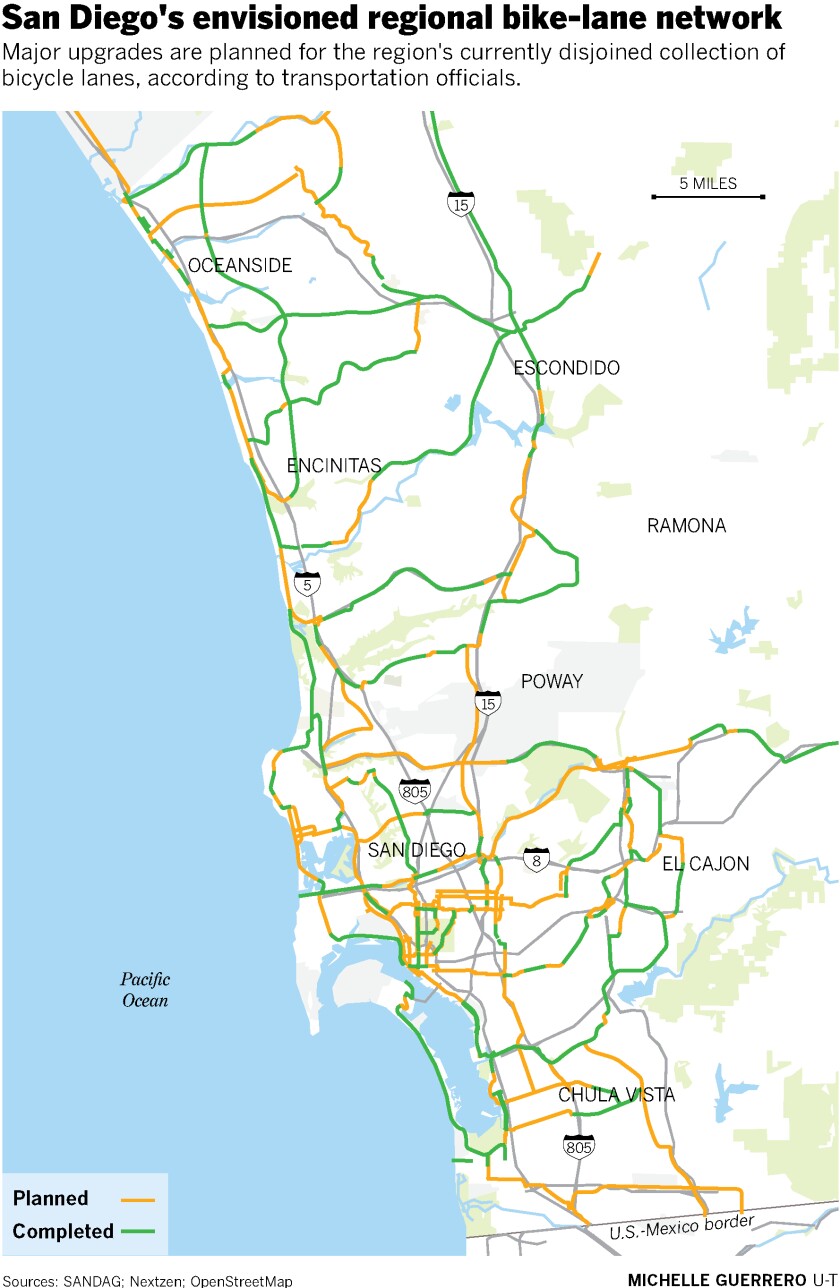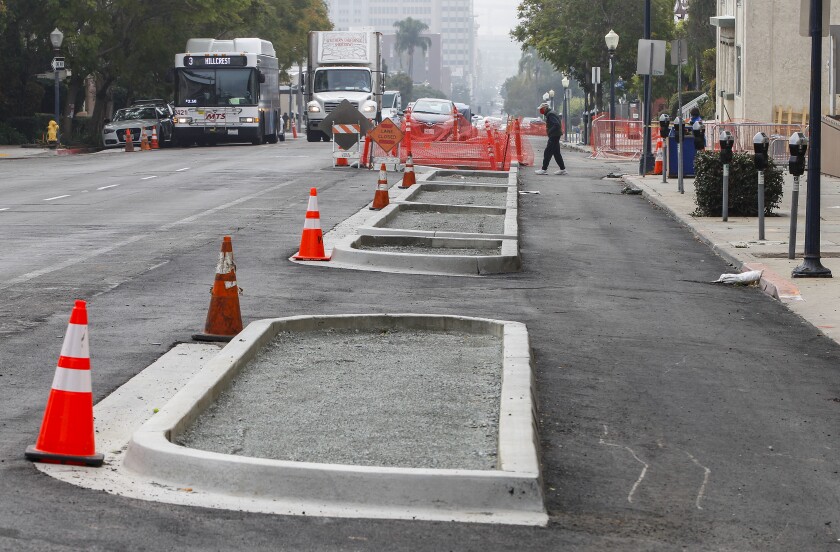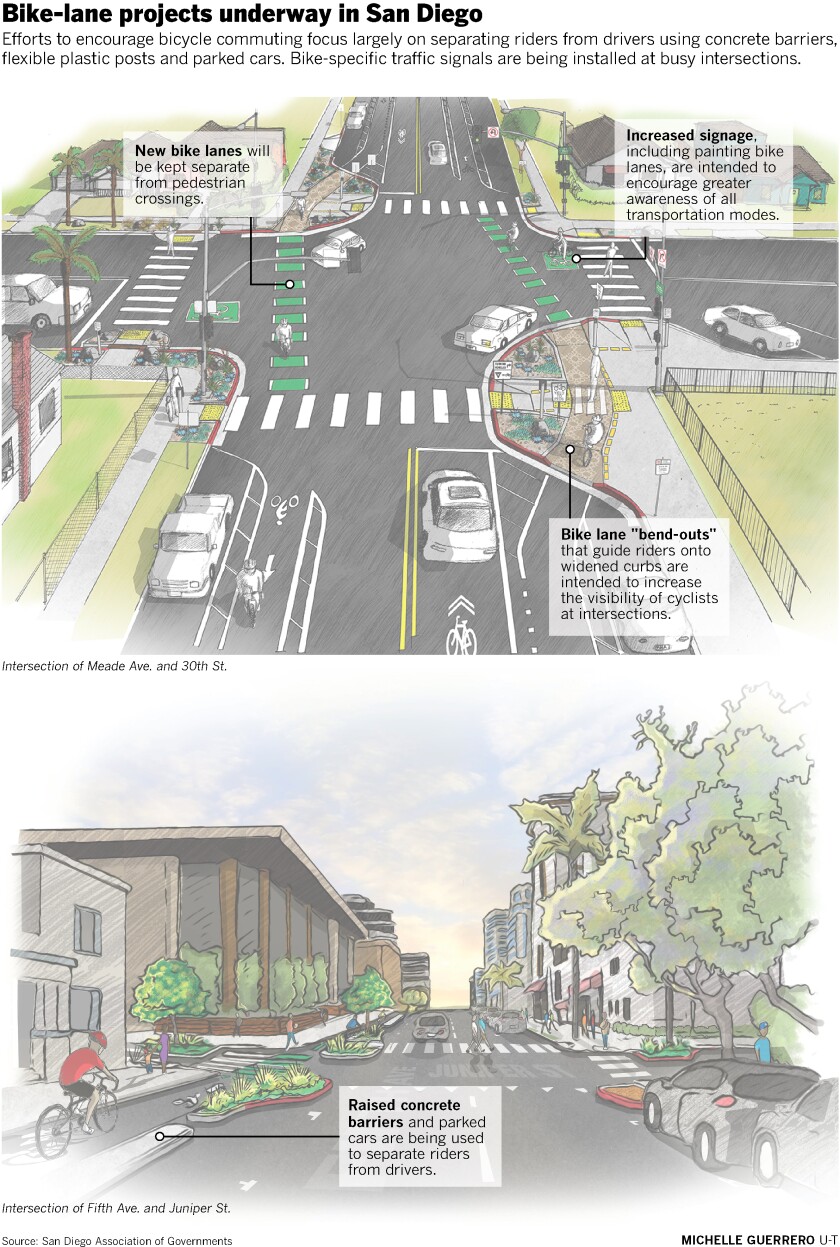Horns blared and wheels screeched on Highway 101 along Cardiff State Beach.
“Did you see that?” exclaimed Serge Issakov, who was out for a ride on a recent Saturday, clad in full green and black cycling attire.
A car making a right turn into a busy restaurant parking lot had, just seconds earlier, come within inches of hitting a cyclist whizzing by in a recently constructed “protected” bike lane that uses physical barriers to separate riders from cars, except at intersections.
“That’s exactly what I’m talking about,” said the 60-year-old software engineer. “The exact same situation killed a guy on Leucadia Boulevard.”
A massive expansion of San Diego’s disjointed and long-delayed network of bicycle lanes now appears to be underway. With liberal politicians squarely at the region’s helm for the first time in modern history and the pandemic pushing biking to record heights, advocates are hoping that new street designs will accommodate even the most novice riders.
“Most people, including me and my kids, would not, in the past, ride to Solana Beach or the Del Mar Fairgrounds,” said Encinitas Mayor Catherine Blakespear, who championed the coastal lanes last year and was reelected in November on a pro-bike platform. “Now it’s barrier protected, and you feel safe, so you do it.”
Many residents in North County have cheered the installation of the bike lanes between Solana Beach and Cardiff, which use concrete curbs, plastic posts and parked cars to shield riders from traffic.
“I just feel like it brings out so many more people,” said Carolyn Whitehouse, 57, who’s started regularly riding to the beach with her friends and family since the lanes were installed. “They love it.”

A view of the south bound bicycle lane as well as a designated walking path (right) and parking areas (left) along Highway 101 near the Las Olas restaurant in Cardiff by the Sea in Encinitas.
(Eduardo Contreras/The San Diego Union-Tribune)
But if the protected lanes are enjoyable for casual riders like Whitehouse, they are an inconvenience for the region’s most enthusiastic cyclists, such as Issakov.
Many experienced cyclists have warned that mixing the region’s high-speed car culture with a profusion of new protected bicycle lanes could at times prove dangerous.
While encouraging new riders, the coastal bike lanes in Encinitas have also been the site of dozens of crashes since last spring. Skilled riders, accustom to traveling upwards of 30 miles an hour, have repeatedly clipped the plastic posts and concrete barriers. Riders emerging from protected lanes have collided in intersections with unwary drivers. A 10-year-old boy swerved to avoid a pedestrian in a bike lane this summer, hit a concrete separator and was thrown into a traffic lane.
Then in November, the prominent local scientist and cyclist described by Issakov was riding his bike along a different protected lane on Leucadia Boulevard when he was fatally struck by a vehicle turning right onto a side street.
Bike-lane supporters say bikers are better off with the protected lanes than they were without them. Others, especially sport cyclists, are skeptical.
Issakov, a 20-year member of the San Diego Bicycle Club who also serves on the city of San Diego’s Mobility Board, has been arguably the region’s most outspoken critic of the traffic-separated lanes. He’s argued for limiting the use of raised barriers near intersections so riders and drivers have more incentive to communicate before turns.
“You got to get rid of the barriers so that cars are forced to merge in with the bikes, and they’re forced to pay attention to each other,” he said.
The legacy of John Forester
San Diego’s relatively late among metropolitan regions when it comes to encouraging bicycling with dedicated lanes.
The college town of Davis experimented as far back as the 1960s with different designs, from merely painted facilities to those separated by parked cars or concrete curbs. By the end of the 1970s, the city had a network across much of the community that relied largely on striped lanes and connected off-street paths.
“The former leaders of Davis saw an opportunity to create a mini-Dutch college town,” said Dillon Fitch, a transportation researcher at UC Davis. “They did some really interesting experimentation. Some of the first lanes they put in were what you might call protected lanes.”
He added, though, that Davis had long abandoned protected lanes with concrete curbs.
“Davis was trying to figure it out, and what they figured out was that these little curbs were actually pretty darn dangerous,” Fitch said. “They were really hard to integrate into intersections that were designed for cars.”
Cycling’s popularity continued to grow around the country during the ‘70s, with elected officials, notably then-New York Congressman Ed Koch, advocating for new bicycle infrastructure.
Engineers and government officials even started to grapple with many concerns still relevant today, including the visibility of bikers in lanes separated from traffic by parked cars, the need to consistently clean trash out of protected lanes and conflicts with pedestrians.
Then came the backlash.
Cyclists who enjoyed traveling at higher speeds feared they would lose their right to ride in the road as lanes and paths proliferated. These so-called vehicular cyclists donning colorful Lycra bemoaned federal and local laws directing bicyclists to avoid the road whenever a usable path was provided.
Enter John Forester, an industrial engineer and amateur bike racer from England who made his home in California. Starting in the 1970s, he spearheaded a cycling movement that would influence state and national politics around bikeway standards for decades.
Forester — who died last year in San Diego at age 90 — believed bike lanes were dangerous for riders. He and his supporters argued the only way to ride safely was in the flow of car traffic.
The popularity of the charismatically gruff Forester grew with his publication of his most famous book Effective Cycling, now in its seventh edition. Through impassioned treatise and public talks, he popularized the notion that bike lanes were designed to keep bicyclists from inconveniencing hurried motorists.
“These guys were really intimidating personalities.”
Bill Schultheiss, of Toole Design
The fact that cyclists were opposing bike lanes confused transportation professionals, who as a result, often sought to avoid the controversy altogether, according to an detailed account published in the journal Transportation Research Record in 2018.
“These guys were really intimidating personalities,” said Bill Schultheiss, co-author of the paper and widely lauded engineering expert at the firm Toole Design. “They were really aggressive, and they created a cult following across the entire country. In every state I ever worked in, I encountered people who would recite his books.”
By 1978, Caltrans had developed its first design guide for bicycle infrastructure, which was heavily influenced by Forester, by then president of the California Association of Bicycling Organizations.
The guide codified his version of vehicular cycling, discouraging cities from using protected bike lanes and side paths.
The document stated: “Many of the common problems are related to improper bicyclist and motorist behavior and can only be corrected through effective education and enforcement programs.”
Forester’s ideology prevailed through the 1980s and much of ‘90s, with limited funding and research dedicated to expanding bikeway networks.
“His main message was, ‘Keep up or get off the road,” said Schultheiss.
A bicycling renaissance
As still-affordable urban areas from Brooklyn to the Bay Area became hip in the early 2000s, so did casual bike riding between jobs, bars and friends’ houses.
The decade saw many cities, led by Portland, Oregon, invest in everything from painted bike lanes to the first protected facilities in more than 40 years. The renaissance in riding, especially among college towns, prompted academic studies that overwhelmingly concluded that bike lanes led to higher ridership.
Over time, some cities developed a culture of courtesy between riders and drivers, said Jennifer Dill, a transportation researcher at Portland State University.
“People started paying attention more,” said Dill, who’s taught at the university for more than 20 years. “I saw that personally. The more people you have out there biking and walking, the safer it gets.”
A major turning point came in 2007 and 2008, when New York City started installing its first protected bike lanes on 8th and 9th avenues. The projects inspired other larger cities to draft similar plans, including in Chicago, Washington, D.C., and eventually San Francisco down to Long Beach.
Traffic engineers embraced bicycle lanes as a way to woo more riders, hoping to tap into a latent demand, said Bob Schneider, a transportation expert at the University of Wisconsin-Milwaukee.
“They were trying to attract people of all ages and abilities,” he said. “They were designing these things so that kids would feel comfortable in them.”
This shift also meant the protected bike lanes were often unsuitable for rushed vehicular cyclists, said Schneider, adding that the popularity of e-bikes and dockless scooters could also be an issue in the future.
“It’s relatively safe for a slower-speed cyclist to be approaching an intersection because they have time to stop and respond to a turning conflict,” he said. “But if someone’s going 20 to 25 miles an hour, they might not be able to.”

San Diego’s vision
Over the better part of the last decade, San Diego has struggled to build out its bicycle infrastructure.
Politicians, such as former San Diego Mayor Kevin Faulconer, promised big investments, but opposition from neighborhood and businesses groups concerned about the inevitable loss of the parking that comes with new protected lanes reduced progress to a crawl.
Most notably, an envisioned nine-mile network of protected lanes in downtown San Diego that was supposed to wrap up last year remains far from completed.
In recent years, the region’s top planning and transportation agency, the San Diego Association of Governments, has spent $145 million on a plan to build more than 60 miles of bike lanes throughout the region, but so far, the agency has only completed about nine miles.

Concrete barriers define a northbound bike lane (right) from traffic (left) along 5th Avenue near Balboa Park. The photo looks southbound on 5th Avenue.
(Eduardo Contreras/The San Diego Union-Tribune)
Now things could be about to change, especially with the recent election of Mayor Todd Gloria. Advocates see his vocal support for reducing greenhouse gas emissions from cars and trucks as reason for hope.
The city’s climate action plan called for cycling to account for roughly 6 percent of commutes by 2020 and 18 percent by 2035. It’s been stuck around 2 percent for years.
“I do think Todd is going to prioritize a lot of this to follow through on the climate plan,” said Andy Hanshaw, executive director of the San Diego County Bicycle Coalition and chair of the city’s Mobility Board. “They’re going to make a good-faith effort to push things forward more than ever.”
On top of that, the pandemic has encouraged thousands of people to start riding more. This summer biking increased by more than 40 percent over last year, although much of that increase come from weekend riding, not commuting, according to SANDAG data.
More than 80 percent of riders surveyed said they planned to keep it up once the lockdown ends.
That trend has provided a tailwind for places such as National City, Chula Vista and Imperial beach, where miles of new protected bike lanes and paths have been recently completed.

Under new leadership, SANDAG also appears to be doubling down on its regional bike network. A major nearly five-mile project along 4th and 5th avenues between downtown San Diego and Hillcrest is under construction, as are about 13 miles of bike lanes between North Park and City Heights that include more than a dozen traffic circles to slow down car traffic.
Engineers and advocates admit these facilities could be dangerous for those traveling at speeds favored by vehicular cyclists. Protected lanes, for example, often collect debris, giving riders few options to avoid hazards other than slowing down. Similarly, blasting into an intersection on a bicycle from behind a wall of parked cars can give drivers little time to react.
“This is to attract the all-ages and abilities groups that are just trying to go places within their communities, but if you need to go fast, the (car) lane is always open,” said Everett Hauser, a traffic engineer focusing on bicycle infrastructure for the city of San Diego.
Many new projects around the region also include bicycle-specific traffic lights at busy intersections and reconfiguring streets to encourage slower driving especially at tight turns.
Still, not everyone’s convinced.
“These protected bike lanes that have appeared in the last few years are the most dangerous thing that’s ever happened to bicycling in San Diego,” said Ralph Elliott, 70, historian of the San Diego Bicycle Club and a member for more than 50 years. “They’re unsafe. If there’s a car door in your face, somebody’s walking in the protected bike lane, skateboarding in the lane, dog in the lane all that’s dangerous because you can’t get out.”
At least in one location, engineers have ceded some ground to the vehicular cyclists.
On the recently installed protected lane along Highway 101, officials are planning to remove barriers up to 100 feet before the entrance to the busy Las Olas restaurant parking lot. The idea is to allow drivers and riders to start negotiating the intersection well in advance of any turns.
The decision is a win for riders like Issakov and Elliott, but officials were quick to point out that much of what they’re building is not intended to please the vehicular cycling community.
“The design was not meant to make things more convenient for them,” said Abraham Bandegan, the Encinitas traffic engineer who oversaw the project along the coast. “The design was supposed to make life a little bit miserable for them, but now a 6-year-old kid can ride to the beach and feel totally protected.”
Article From & Read More ( Sport cyclists and car culture collide in San Diego's massive expansion of bike lanes - The San Diego Union-Tribune )https://ift.tt/38u0Kbh
Sport
Bagikan Berita Ini














0 Response to "Sport cyclists and car culture collide in San Diego's massive expansion of bike lanes - The San Diego Union-Tribune"
Post a Comment